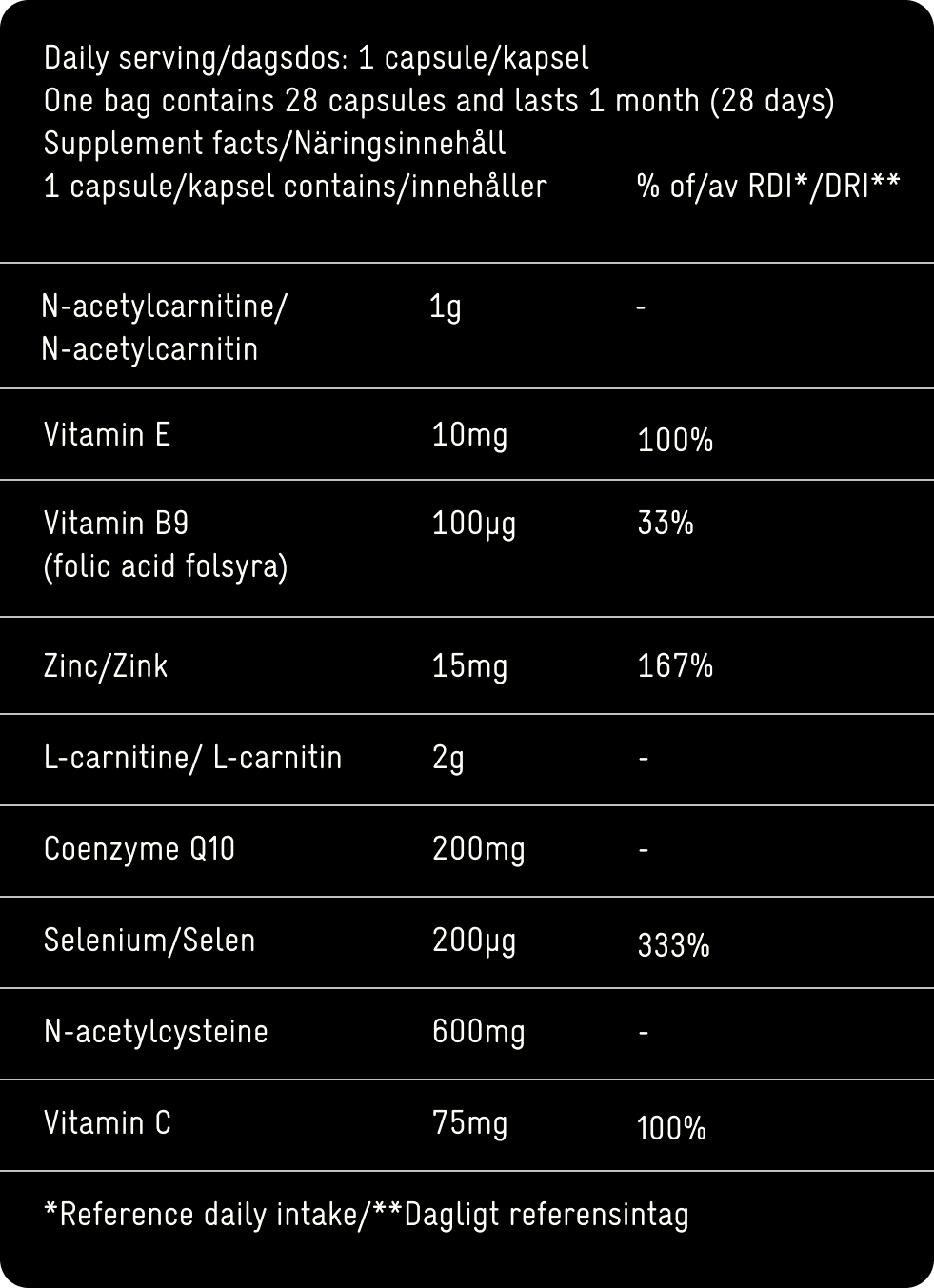Increases the amount of semen containing sperm
Increases the ability of sperm to swim forward.
Increases the number of sperm in a given amount of semen
Increases the percentage of the total number of sperm that has a normal appearance: an oval head, a "neck"/midsection and a tail
What is a sperm?
A sperm is a cell, with half a set of DNA, with the task of creating a new organism together with an egg cell.
How are sperms formed?
Sperm are formed through a process called spermatogenesis, involving several steps that allow a stem cell (spermatogonium) in the man's testicle to develop into a sperm. This process can be divided into five steps:
Spermatogonia division
Divides to develop a primary spermatocyte (a sperm cell). In this cell there are 46 chromosomes divided into 23 chromosome pairs, which together make up the entire genetic mass.
Meiosis I.
Meiosis is a division that means that only half of the genetic material comes with it. Normally, we talk about Mitosis, which is a cell division that tries to exactly copy the original cell. The new sperm cell resulting from this division now has only one of each chromosome in it (and is called a secondary spermatocyte).
Meiosis II
The secondary spermatocyte undergoes another meiosis, which again divides the genome in two. This time, entire chromosomes will no longer be intact, but a division of each chromosome will take place. The result is four haploid sperm cells.
Spermiogenesis
The sperm cell undergoes a number of changes such as developing a head, neck and tail, to later have the ability to swim and fertilize an egg.
Maturity phase
The immature sperm is transported to the epididymis where it will be matured and then stored until it is time for ejaculation.
What is sperm concentration?
Sperm concentration is the number of sperm in a given amount of semen. It is usually measured in millions of sperm per milliliter and is one of the parameters looked at when doing a sperm analysis
What is sperm motility?
Sperm motility is the ability of sperm to swim forward. Motility is usually measured as a percentage of the total number of sperm in a semen sample. The more sperm in the sample that move forward, the higher the percentage.
- In sperm analysis, motility is often divided into two categories:
Progressive motility - Sperm that have the ability to swim straight or in large circles - Non-progressive motility - Sperm that move, but not straight or in large circles
What is normal sperm concentration?
Anything over 15 million sperm per milliliter is considered normal
What is sperm morphology?
Sperm morphology refers to the shape of the sperm. Morphology is usually measured as a percentage of the total number of sperm in a normal-appearing semen sample. A normal appearance involves an oval head, a "neck"/midsection and a tail
Which factors in the seminal fluid determine fertility?
When looking at the seminal fluid to assess fertility, the following parameters are looked at:
-
Sperm concentration
-
Sperm motility
-
Sperm morphology
-
Total motile sperm count
-
Semen volume
How many sperm are formed per day?
The number of sperm a man produces per day varies greatly. But on average it is millions per day. According to the World Health Organization (WHO), men produce 20-150 million sperm a day. Important to remember is that 150 is not necessarily "better" than 20, as factors such as age, health, genetics and lifestyle come into play.
How can I improve my sperm concentration?
There are several ways that can potentially improve your sperm concentration, which are suggestions that come from what is known today can negatively affect sperm concentration. These are among others:
Avoid smoking
-
Avoid large amounts of alcohol
-
Exercise regularly
-
Eat 500g of fruit and vegetables a day
-
Reduce everyday stress
-
Avoid exposure to toxins such as pesticides and heavy metals
-
Treatment of any conditions that may affect sperm quality such as varicocele and hormonal disorders
-
Optimize intake of vitamins and minerals
What affects sperm concentration, motility and morphology?
Sperm production can be negatively affected by several factors such as:
-
Heredity
-
Infections
-
Environment
-
Lifestyle
-
Medical conditions such as varicocele and hormonal disorders
Take 2 tablets twice a day with meals. Do not exceed the recommended daily dose. Caution should be exercised by people with cardiovascular disease and by people medicating with anticoagulants. Always consult your physician before taking supplements. Food supplements should not be used as a substitute for a varied diet. Store in a cool, dark and dry place. Keep out of reach of children.
Dietary supplement: Do not exceed the recommended daily dose. Not to be used as a substitute for a varied diet or a healthy lifestyle. Keep out of reach from small children.
-
 Sugar Free
Sugar Free
-
 Corn Free
Corn Free
-
 Gluten Free
Gluten Free

